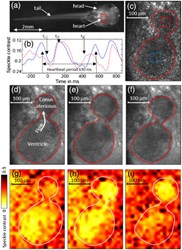Two-In-One Light Source Provides Functional And Structural Biomedical Images

Simple, VECSEL-based light source used to image tadpole embryo’s beating heart
Researchers have designed a simple new laser system that allows the acquisition of two types of microscopy images with a single light source. In a demonstration of the system’s impressive potential for biomedical applications, the researchers used it to dynamically image the blood flow and miniscule structural changes of a tadpole embryo’s beating heart.
Although others have achieved multimodality imaging using different light sources, it has been challenging for these systems to maintain optical alignment during switching and to adjust for mismatches in illumination intensity.
“What is unique is that we have a very simple design for a laser system that can switch back and forth between different operating modes with essentially the same beam, keeping the direction and optical powers similar so that everything stays well-aligned,” said Hui Cao, Yale University, Applied Physics Laboratory, who developed the laser system.
The researchers report on the new light source, which is based on a vertical external-cavity surface-emitting laser, or VECSEL, in The Optical Society's journal for high impact research, Optica.
Imaging structure and function
The new light source grew out the researchers’ work to develop a laser that could eliminate the speckle pattern that obscures images acquired using laser light. Speckle is an optical artifact created by lasers’ high spatial coherence — the fact that the light waves emitted from a laser are all synchronized, or in step with each other.
Illuminating a sample with a non-coherent light, such as that from LEDs or a white lamp, doesn’t cause speckle. However these light sources aren’t bright enough for the fast imaging speeds, and thus short exposure times, required to follow dynamic biomedical processes such as a beating heart.
In developing their new system, Cao and colleagues took advantage of the fact that the particular pattern of speckle created by a sample can provide information about the dynamics of the cells scattering the light. Since the 1990s, a method called laser speckle contrast imaging has used the temporal change of speckle to provide information about blood flow.
The new laser system can create light with low spatial coherence for speckle-free structural images or be quickly switched to high spatial coherence for speckle contrast imaging of the same tissue.
The researchers conducted an initial demonstration of their light source by imaging a beating heart from a Xenopus tadpole, an animal model that Michael Choma, coauthor of the paper, is studying to better understand heart disease. The researchers first acquired low-coherence images to show the heart’s structure and how it changes during a heart beat. They then switched to high coherence to measure the flow of blood through the heart using laser speckle contrast imaging.
“For animal models such as Xenopus, it is important to have straightforward ways to assess heart function,” Choma said. “This allows us to understand the effects of a gene mutation related to congenital heart disease or to study the impact of a drug on embryo heart function.”
The new light source might one day be useful for clinical applications that involve visualizing and quantifying blood flow in the retina or during certain surgeries.
“The ability to design and tailor the spatial coherence state of laser light in very precise ways opens up new opportunities to study different heart and lung diseases that are of great interest for my research and are of great public health importance,” Choma said.
Two light sources in one
The new light source features a very simple design of only five optical elements plus a VECSEL. The VECSEL emits light from multiple sites, with the light from each site slightly out of step with all the others. The researchers used all 1,000 independent modes of light coming from the VECSEL to generate low-coherence light. By adding a pinhole to the laser cavity, they were able to concentrate all the laser power into just a couple of modes to create high-coherence light for laser speckle contrast imaging.
“Our optical set up is compact, very easy to put together and also inexpensive,” said Cao. “All the optics and the VECSEL are commercially available, off-the-shelf components.”
As a next step, the researchers plan to refine the system by using a type of digital mirror array called a spatial light modulator to switch between low and high coherence many times during one heart beat. This would allow almost simultaneous imaging of blood flow and structure.
About Optica
Optica is an open-access, online-only journal dedicated to the rapid dissemination of high-impact peer-reviewed research across the entire spectrum of optics and photonics. Published monthly by The Optical Society (OSA), Optica provides a forum for pioneering research to be swiftly accessed by the international community, whether that research is theoretical or experimental, fundamental or applied. Optica maintains a distinguished editorial board of more than 30 associate editors from around the world and is overseen by Editor-in-Chief Alex Gaeta, Columbia University, USA. For more information, visit Optica (https://www.osapublishing.org/optica/home.cfm).
About The Optical Society
Founded in 1916, The Optical Society (OSA) is the leading professional organization for scientists, engineers, students and entrepreneurs who fuel discoveries, shape real-life applications and accelerate achievements in the science of light. Through world-renowned publications, meetings and membership initiatives, OSA provides quality research, inspired interactions and dedicated resources for its extensive global network of optics and photonics experts. For more information, visit osa.org/100.
Source: Optica
